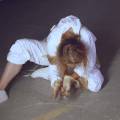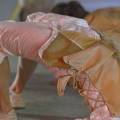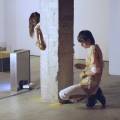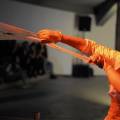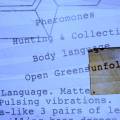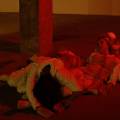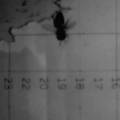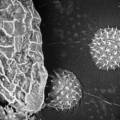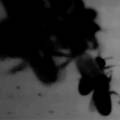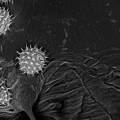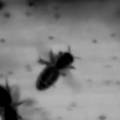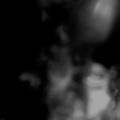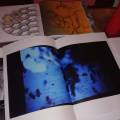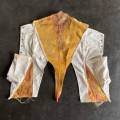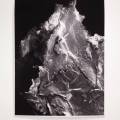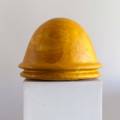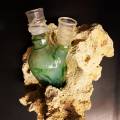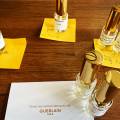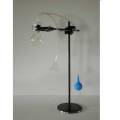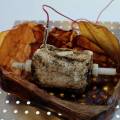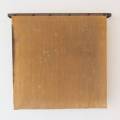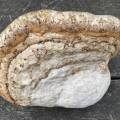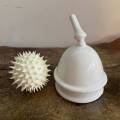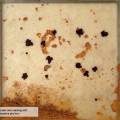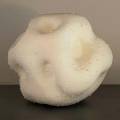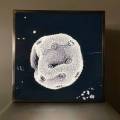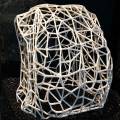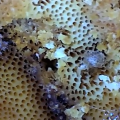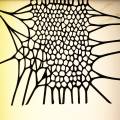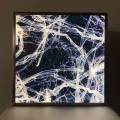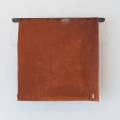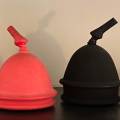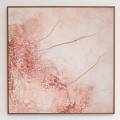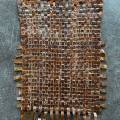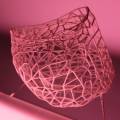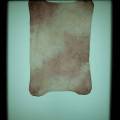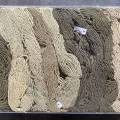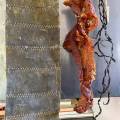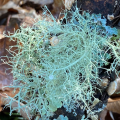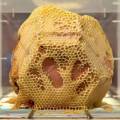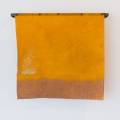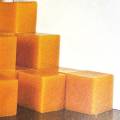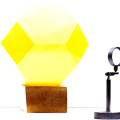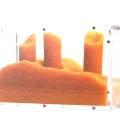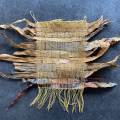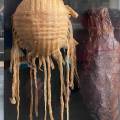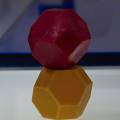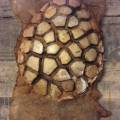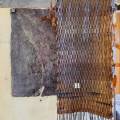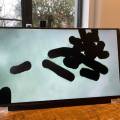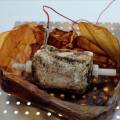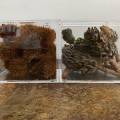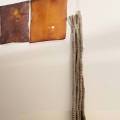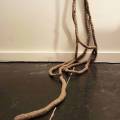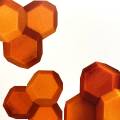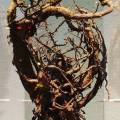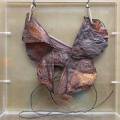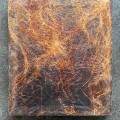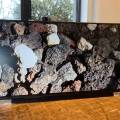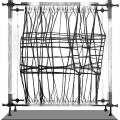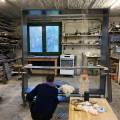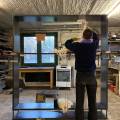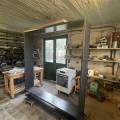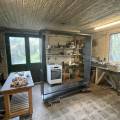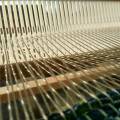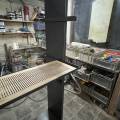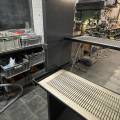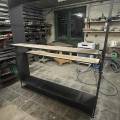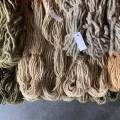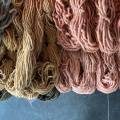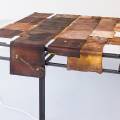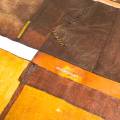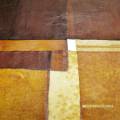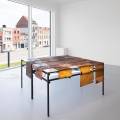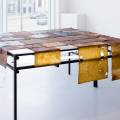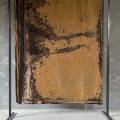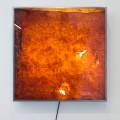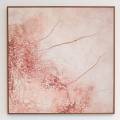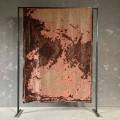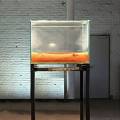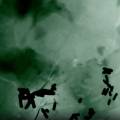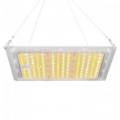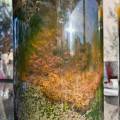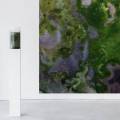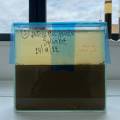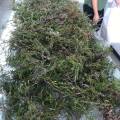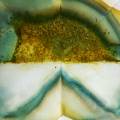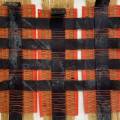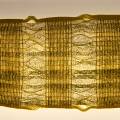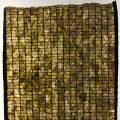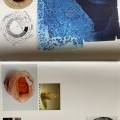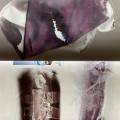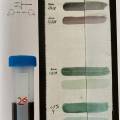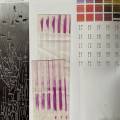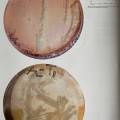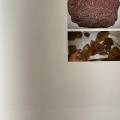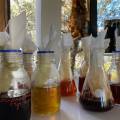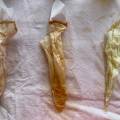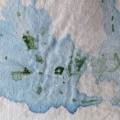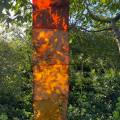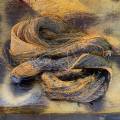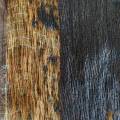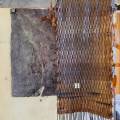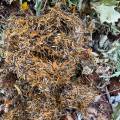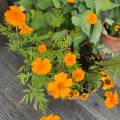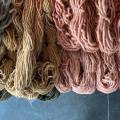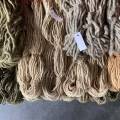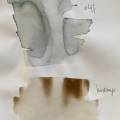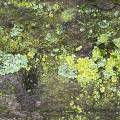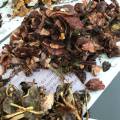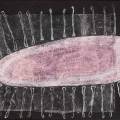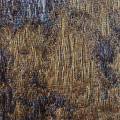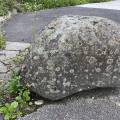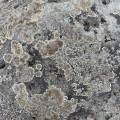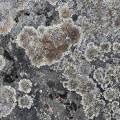This is an old revision of the document!
Table of Contents
ALCHIMIA NOVA - PRODUCTION
concept expo Alchimia Nova
ALCHIMIA NOVA is de titel van de solo tentoonstelling van Anne Marie Maes in Kunsthalle Mulhouse (02.2023 – 04.2023). Na recente presentaties in het Palais de Tokyo en het CWB in Parijs (beide juni 2022) is dit de eerste solo expo van Anne Marie Maes in Frankrijk.
In deze expo focust Maes op organische netwerken en op de symbiotische relaties tussen levende organismen - inclusief planten, bacteriën en schimmels. Ze onderzoekt het ecosysteem van de Elzas-regio aan de hand van een kleurenpalet geëxtraheerd uit lichens, schimmels, planten en bacteria. De symbiotische relaties van het bodemleven staan garant voor een gezonde grond waarin wilde planten floreren. De tinten en de saturatie van de pigmenten worden beïnvloedt de alchemie van de grond waarin ze leven: de pH van de aarde, de hardheid van het regenwater, de uren regen en zonneschijn. Maar lichen, planten, schimmels en bacteriën zijn ook verhalenvertellers die ons verbinden met onze omgeving door hun kleuren, hun geuren, de herinneringen die ze oproepen. Het verkregen palet zal verwerkt worden in een reeks nieuwe kunstwerken, gerealiseerd met innovatieve methodes (zoals ‘live’ weaving tijdens performances) en in nieuwe materialen zoals bio textielen en 'microbial skins'.
Dit project sluit aan bij een van Maes’ langlopende projecten, nl. Het Lab voor Vorm en Materie (Lab for form and Matter) waarin de kunstenaar sinds lang experimenteert met organische materialen die o.a. medegecreëerd zijn door bacteria, algen en insecten.
Dit onderzoek wordt gevoed door het werk van wetenschappers als Lynn Margulis (Symbiotic Earth) en Donna Haraway (Tentacular Thinking). Donna Haraway gebruikt de term tentaculair denken als een kritiek op een visueel gedomineerde, antropomorfe vorm van denken. Zij stelt dat de wereld zou moeten worden waargenomen door aan te raken, te voelen en dingen uit te proberen. De notie van tentaculair denken stelt ons in staat om verder te denken en te handelen dan binaire indelingen, en opent ons bewustzijn voor de veelheid aan dingen die we nog niet volledig kunnen herkennen en begrijpen. 'We are all Lichens'. Deze zin maakt op een eenvoudige manier duidelijk hoe we allemaal afhankelijk zijn van andere organismen om te worden wie we zijn.
Deze denkwijze past volledig in het artistiek onderzoek van Anne Marie Maes. Met o.a. haar ‘Sensorial Skins’ en ‘Bee Agency’, voert de kunstenares sinds lange tijd een niet antropocentrische kunstpraktijk. Deze invalshoek wordt doorgetrokken in de exploratie van de onderwaterwereld (Theatrum Algaerium, Laminaria), en de plantenwereld (Connected OpenGreens).
Centraal in de opstelling van ALCHIMIA NOVA staat de installatie ‘the Lab for Form and Matter’. De opstelling in de Kunsthalle Mulhouse wordt uitgebreid met nieuw werk, nl. een Wunderkammer waar naast het eigen kleurenonderzoek ook de samenwerking met de Universiteit Strasbourg aan bod komt. Verder komt er een monumentale sculptuur, een dubbelzijdig weefgetouw dat technisch precies is uitgevoerd in opgeschuurd metaal (voor tekeningen en details productie, zie link research webpagina). In deze sculptuur (240cm hoog, 200cm breed) contrasteren koele materialen (de minimalistische industriële look en het koele weerspiegelende lichtgrijs van het opgeschuurde metaal) met de warme materialen van de draden en garens geverfd die geverfd zijn met de natuurlijke pigmenten. Tijdens de tentoonstelling is deze sculptuur het kloppend hart, waar performances zullen worden uitgevoerd in wisselwerking met de wetenschappers, met collega-kunstenaars en met het publiek.
De residenties tijdens het project zijn een samenwerking met het Lab Microbiologie en Lab Pharmacopie van de UNISTRA research aan Université de Strasbourg. De productie van de expo wordt gesponsord door N.A! Projects Nature Addicts.
bio Anne Marie Maes
AnneMarie Maes (BE) beweegt zich op het snijvlak tussen kunst en wetenschap, met grote interesse voor DIY-technologieën en biotechnologie. Ze werkt met een scala aan biologische, digitale en traditionele media, waaronder levende organismen. Haar artistiek onderzoek materialiseert zich in techno-organische objecten die geïnspireerd zijn op feitelijke/fictionele verhalen; in artefacten die een combinatie zijn van digitale fabricage en vakmanschap; in multispecies samenwerkingen, in polymorfe vormen gecreëerd door eco-data, in modellen en materialen gecreëerd door micro-organismen. Haar langlopende projecten Connected Open Greens, Bee Agency en Laboratory for Form and Matter, waarin ze experimenteert met bacteriën en levend textiel, vormen een kader voor een breed scala aan installaties, sculpturen, videos & fotowerken, objecten en boeken.
production/presentation at the Kunsthalle
Alchimia Nova is een tentoonstelling die de nadruk legt op het proces. Regelmatig worden nieuwe werken gepresenteerd, die voortkomen uit acties, happenings, performances gedurende de tentoonstelling.
Er is echter ook reeds een selectie van werken aanwezig aan de start. Ook deze werken zijn het resultaat van procesmatig werken, tentoonstellen, voortwerken, updates tentoonstellen … Het volledige proces van research, productie en expo/performance wordt gedocumenteerd in een artist book (SEM, soil bacteria, plantencomposieten, herbaria, prints op stoffenbladzijden en delen op stroken prints)
Central piece of the exhibition is the Lab for Form and Matter: a real-size laboratorium with Wonder Wall and large working tables. A larger-than-life Loom is positioned in the middle of the lab. A series of plinths in different heights (with aquariums for growing bacterial skins and making bio textiles) are positioned throughout the lab.
1. video black box:
- video 'a Bee is a Bee is a Bee'
- video 'Variation Games'
de twee videos geprojecteerd tgo. mekaar in de black box
2. ruimte naast de black box:
- kleinste muur: photo Exoskeleton or lightbox Yellow Skin
- grootste muur: Golden Beehive (tablet op muur)
- Bee parfum Open BioLab
- Bee parfum Guerlain
- artist book performance Tokyo
3. wonder wall part#1
Het Laboratorium voor Vorm en Materie is een onderzoeksproject naar artistieke praktijken in het post-digitale en post-media tijdperk. Het bevindt zich op het snijvlak van biologie, ecologie, technologie en hedendaagse cultuur. Het onderzoek wordt gevoed door mijn interesse in planten en bacteriën als medium voor artistieke expressie en door een zekere fascinatie voor natuurlijke structuren en organische processen op microscopisch niveau. De artistieke neerslag van dit onderzoek kristalliseert zich in de creatie van sculpturen, objecten, video's, foto's en installaties.
In mijn Laboratorium onderzoek ik door middel van verschillende digitale en traditionele technieken de creatie van biotextiel, zowel met plantaardige materialen als met micro-organismen. Ik onderzoek de mogelijkheden van bacteriële biofilms voor eco-monitoring en experimenteer met de implementatie van organische materialen in objecten.
The Laboratory for Form and Matter is a research project on artistic practices in the post-digital and post-media era. It is located at the intersection of biology, ecology, technology and contemporary culture. The research is fueled by my interest in plants and bacteria as a medium for artistic expression and by a certain fascination with natural structures and organic processes at the microscopic level. The artistic precipitation of this research crystallizes in the creation of sculptures, objects, videos, photographs and installations. In my Laboratory I explore the creation of biotextiles through various digital and traditional techniques, both with plant materials and microorganisms. I explore the potential of bacterial biofilms for eco-monitoring and experiment with the implementation of organic materials in objects.
WHITE
‘O Tiger-lily,’ said Alice, addressing herself to a flower that was waving gracefully about in the wind, ‘I wish you could talk!’
‘We can talk,’ said the Tiger-lily: ‘when there’s anybody worth talking to.’ Alice through the Looking Glass, Lewis Carroll.
PINKISH-RED
GREEN
I wanted to know what causes a given kind of work to be regarded by women as embarrassing, both in the past
and in the present: whether this has to do with the way the material is handled or whether it really lies in the material itself. Rosemarie Trockel.
YELLOW
BROWN
The names of brown dyes are sweet and edible. You can buy a coat in caramel,toffee, almond, coffee, chocolate or curry. Brown is sweetness and nourishment. There was once a colour called toast. Derek Jarman, Chroma.
4. loom as sculpture
Wij gebruiken het weven als een medium om kenmerken uit de plaatselijke omgeving weer te geven. Door te werken met primair materiaal dat geverfd is met pigmenten die gewonnen zijn uit lokaal geoogste planten, proberen we nieuwe manieren te creëren waarop milieu-informatie kan worden uitgedrukt en ervaren.
Een groot dubbelzijdig weefgetouw in geborsteld metaal wordt gepresenteerd als een sculptuur. High tech precisie design, industriële look.
We use weaving as a medium for representing characteristics taken from the local environment. By working with primary material dyed with pigments extracted from locally harvested plants, we try to create new ways in which environmental information can be expressed and experienced.
A large double-sided loom is produced in in brushed metal (or in high quality wood) at LaserTek Mechelen (Belgium). High tech precision design, industrial look.
5. Sensorial Skins
Sensorial Skins en bio-textiles (installation)
With my Sensorial Skins I investigate the sculptural potential of organic materials. Together with bacteria I transform fermenting cultures into fabrics, membranes and biofilms. I thus create complex surfaces that arouse our senses through their materiality, their texture, their colours and smells.
The ever-evolving fabrics shrink, harden or soften in response to humidity, temperature and other parameters of the environment. They result from processes reminiscent of alchemical practices, grounded in fieldwork and scientific methodology.
The fabrics become interfaces between the human and the non-human, the macroscopic and the microscopic. They transform the natural into the cultural realm.
6. tapestries + aquaria with living cultures + lichen stone
* Three Monochrome Skins: the Song of the Bees (wall tapestries i.s.m. TextielLab Tilburg)
The Stone, a monumental sculpture with living organisms (fungi and algae)
7. Winogradski Colums
Winogradski Columns: a Living installation with soil bacteria. Model microbial ecosystems prepared by adding pond sediment to a clear cylinder with additional supplements and incubated with light. Environmental gradients develop within the column creating diverse niches that allow enrichment of specific bacteria).
Samen met de microbiologen van UniStra (Universiteit Strasbourg) werken we op visualisaties van de inhoud van de grondsamples van de regio, met de SEM (voor dood bacterieel materiaal) en met de lichtmicroskoop (voor onderzoek van het levend bacterieel materiaal). Selectie maken van interessante samples (bacteria, soil micro-organisms, tardigrades, lychen, cyanobacteria, plantenonderdelen, grondsamples).
8. wonder wall part#2
9. entry Kunsthalle
Artist Book
Handgemaakt boek over het ganse proces. Verslagen van de residenties. Overzicht van de expo in progress.
Workshop Winogradski columns
With the N.A. ambassadors.
Workshop critical writing
With the students of the mastes Critique et Essais
keywords: Alchemie / Fieldwork / Ethnobotanics
L'exposition porte sur la chimie artistique, la transformation de matières premières, la nature, la biologie, la perception des couleurs, notre relation au sol et aux micro-organismes qui en déterminent la qualité; et cette qualité du sol qui détermine à son tour le contenu des plantes.
Plants enable us to develop a sensibility of the environment.
Collaborate with students on the plant/color/region concept via environmental storytelling. What are the local names of the plants? Are there specific stories connected to the names, to the places where plants were collected? Songs? Medicinal qualities? Ethnobotany? Wood Wide Web connected via plant roots and mycelium.
Ethnobotanie: L'ethnobotanique est l'étude des plantes d'une région et de leurs utilisations pratiques à travers les connaissances traditionnelles d'une culture et d'un peuple local. Un ethnobotaniste s'efforce donc de documenter les coutumes locales impliquant les utilisations pratiques de la flore locale pour de nombreux aspects de la vie, comme les plantes en tant que médicaments (ex. Arnica), aliments, substances intoxicantes et vêtements.
Fieldwork: La recherche sur le terrain est une méthode de collecte de données qualitatives visant à comprendre, observer et interagir avec des plantes dans leur environnement naturel.
Alchimie: Les alchimistes croyaient que la base du monde matériel était une Prima Materia, ou matière chaotique primaire, qui pouvait être amenée à l'existence si elle était impressionnée par une “forme”. Les “formes” prenaient la forme des éléments, la terre, l'eau, le feu et l'air. Les alchimistes en ont déduit que les variétés illimitées de vie étaient créées par le mélange des éléments dans des proportions particulières.
contributions:
- quotes on color zones displayed on the wall, short notes and short essays/stories for artist book (cfr. book gardening and botany)
- artist book
- critical texts
Reading:
- Stefano Mancuso: L'Intelligence des plantes: Sensibilité et communication dans le monde végétal / La Révolution des plantes: Comment les plantes ont déjà inventé notre avenir
- Jean Jacques Rousseau: Lettres sur la Botanie
Joseph Beuys: Nature Matière Forme
- Bedouin Ethnobotany: Plant Concepts and Uses in a Desert World
- Derek Jarman: Chroma
- Johannes Itten: Art de la Couleur
- Bauhaus Imaginista: Chapter 2: Learning from
- The Chemistry of Plants: Perfumes, Pigments and Poisons
- Le Peuple Microbien
- Rosemarie Trockel: Wool Abstractions, Knitted Paintings (Trockel's paintings are still subversive for many reasons: all these artworks made with a material and a technique associated with women's crafts, pose questions to viewers.)
- Silvia Federici: Caliban and the Witch
- Anna Tsing: The Mushroom at the End of the World
Titles:
Inspiration from names of plants, places where the plant samples were collected and how the plants are locally used.
- visual thinking
- uncensored actions
- this is blue not red
- color assistant
- cfr. Gertrude Stein books
Symposium: art/science, une fertilisation croisé
- ronde tafel, 5 à 6 participanten
- Chuz Martinez / Luc Steels / Stéphanie Pécourt / Amandine Kopp / Christophe Chailloux / AM Maes / Pierre Fechter
- 15h/18h table ronde; 18h/19h visite guidé expo (+perfo); 19.30/21h buffet; 21h30 performance ou film
- laatste week maart

